How to make the perfect party platter and grazing board
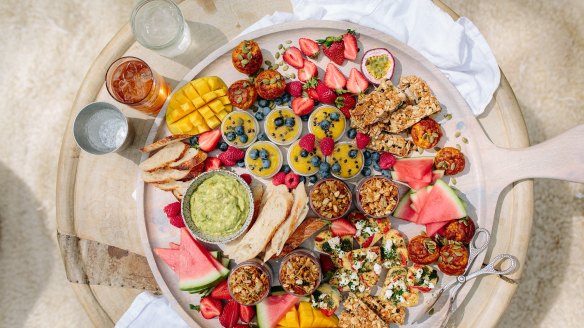
Put down the cabanossi, step away from the cheese cubes. Party season is fast approaching and it needn't be another Jatz-fest. Before resorting to a bowl of sad crisps and cheap dips, consider the new party platter: fresh, hand-made and richly detailed.
Brimming with beautiful fruits, shaved meats and quality produce, these so-called "grazing plates" have become obvious fodder for social media. But they have a practical element, too.
"The beauty of a platter [is] having a little bit of everything, not just one thing," says Bianca Monley of Sydney catering company Little Magic Feast. "It's a great way for people to come together and bond over food."
They're a sensible alternative to dinner parties, too. "It's easier for the host – you can have it all ready before everyone comes and when they arrive you can just pop the champagne and actually enjoy yourself rather than being in the kitchen the whole time," Monley says. "And you've only got one plate to wipe down at the end."
Here's how to make your own.
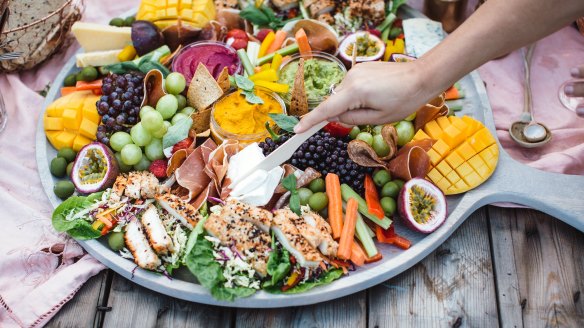
Go for quality
Never skimp on quality or cut corners with cheap produce – that's Monley's top tip. Her dips are made in-house from avocado, beetroot and cannellini beans, as are the nut and seed lavosh, and treats such as mint slice and caramel popcorn.
"Quality is everything," Monley says. "Where you got the food from [often] becomes a talking point around the platter."
That doesn't mean you have to make your own crisp bread from scratch, or spend a fortune on fancy crackers, though. Local farmers' markets tend to have most items at a reasonable price, or if not, gather a small selection of quality items at a boutique grocery.
Start with a few fresh, seasonal fruits and vegetables, choose a mixture of seeded crackers, and round out your shopping list with a couple of good cheeses: a creamy blue, King Island cheddar or, Monley's favourite, d'Affinois.
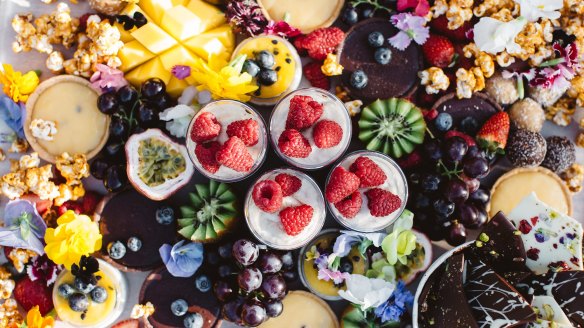
Make it colourful
People really do "eat with their eyes", Monley says, so the more colourful your platter, the better. Berries and fruits give it a visual "lift", and edible flowers add a delicate touch.
"We also use a diversity of products – nuts, seeds, crackers, katsu curry salad cups – there's something on there for everyone."
A fun display is particularly important for children, though quantities can be much smaller. Cut cucumbers cut into stars or watermelons into hearts, for example, and get the kids involved by asking them to place blueberries on circles of watermelons as eyes.
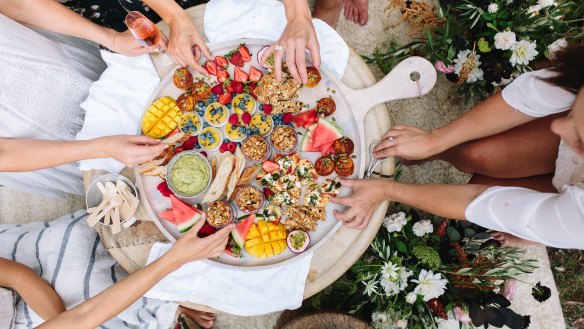
Platter by numbers
Groups of threes give your platter an attractive symmetry, Monley says. "Three different cheeses, three different crackers, three different berries – it just balances nicely on a platter."
Rather than placing "clumps" of single ingredients over your board, Monley suggests spreading items around evenly. This looks better, and means your guests can reach for ingredients from any part of the table.
Start by spacing three cheeses across the board, then slowly build around them, filling in any gaps with crackers, lettuce cups and small snacky items such as nuts and fruit, and finishing with the brightest berries or flowers on top.
Alternatively, place one big cheese in the centre on a stand, and build around that wheel. And for real "wow" effect, use the biggest round wooden platter you can find.
Keep it bite-sized
"Don't put anything too big that's going to be too awkward [to eat]," Monley says. "Everyone wants one or two bites maximum. The whole beauty is you can eat a little bit of everything and you won't be too full to eat anything else."
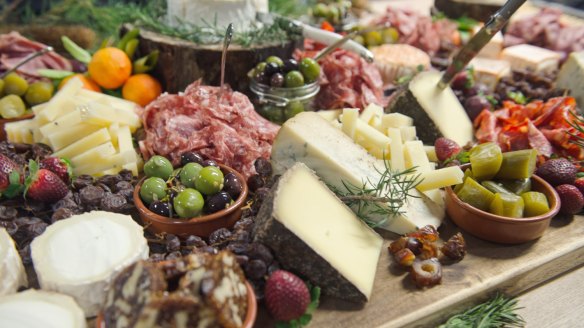
Get cheesy
Jamie Nimmo from the Stinking Bishops in Sydney's inner west generally chooses four types of cheeses for his platters: a softer white cheese (think camembert, brie or goat's cheese), a hard cheese, a semi-hard and a washed rind or blue mould.
For hard aged cheeses such as gouda, he often slices them into little strips, making them easier to pick up and eat.
Softer cheeses such as a Burgundy epoisses can be harder on the nose, so Nimmo suggests checking your venue's ventilation before dishing out the stinkier varieties.
"A lot of them grow similar bacteria [to the kind] you find under your arms or in between your toes so they do have quite an emission of scent," he says.
"England is doing really interesting washed rinds, but like our namesake the stinking bishop cheese, they are polarising so check with your guests whether they're up for a challenge."
Likewise, older-style blues can be overly intense or acidic, but "once you start stepping into the modern world of blues you have quite a broad range of flavours". Ask your closest cheesemonger for a milder "beginner blue" such as Colston Bassett's Shropshire or a Gippsland buffalo blue, and you'll keep your guests happy, Nimmo says.
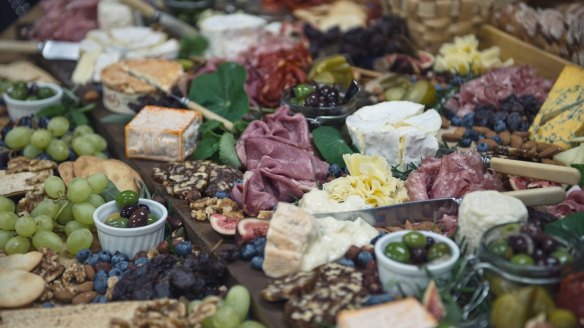
Meat selection
Nimmo follows a similar principle for sliced meats, mixing up different Italian styles with Spanish, English and Dutch, or a truffle salami with a beef alternative, chorizo and French saucisson. For extra punch, he suggests the spicy spreadable salami called 'nduja. "You don't want to eat too much," he says.
Rich fig roulades, fruit pastes, muscatels and salted nuts enhance the flavour of the cheese and meat, but plain crackers or sourdough are best. "I try to stay away from crackers with added flavours. They colour the cheese flavour too much," Nimmo says.
Arranging your meats and cheeses on log cuts or in bowls with herbs and citrus gives your display extra height and colour, too, Nimmo says.
Beware the heat
Australian summers can wilt an expensive platter in no time, so if a scorcher is on the way, ask your cheesemonger for more robust cheeses that are less likely to sweat or split, Nimmo says.
Or try a smaller platter with half-serves of cheese, keeping the other portions refrigerated until needed (save any leftovers for making cheese-on-toast or scrambled eggs the next day). Steer clear of hot food, too, or at the very least serve it separately from chilled items.
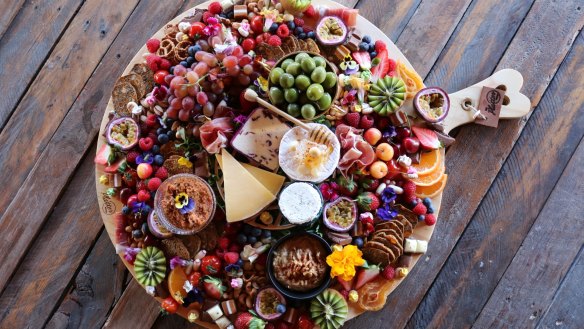
Go all out
Don't be afraid to include plenty of variety and visual props or flowers, says Megan Fernandez from Your Platter Matters on the Gold Coast.
She creates three-metre medieval-style platters inspired by the abundant feasts and marketplaces shown on Game of Thrones, and all sorts of arrangements that mix sweet with savoury.
"You want everyone to have at least a handful of things they love on a platter," Fernandez says. "Even the pickiest people should still have things they will enjoy."
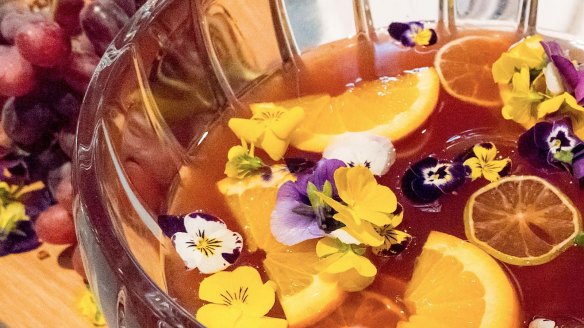
Add some punch
Hamish Ingham and Rebecca Lines from Banksii at Sydney's Barangaroo incorporate a centrepiece of house-made punch made with vermouth into their platter party menu. They mix vermouth with grapefruit juice in a bowl with fruit alongside a jar of ice and a ladle for guests to pour their own drinks. prosecco can then be added to make a DIY spritz cocktail.
"Ultimately it's about giving diners flexibility, they can make their drink as strong or as weak as they like," Ingham says.
"We've been doing share plates of food for a long time. The reason it works is that it is immediately interactive; diners are relaxed and engaged. So we thought we would do the same with the drinks.
"The trick to making it taste delicious is all about balance. Different vermouths have different flavours so we mix it up – we can match the botanicals in the vermouth to different flavours of fruit as the seasons change."
Appears in these collections
The best recipes from Australia's leading chefs straight to your inbox.
Sign up